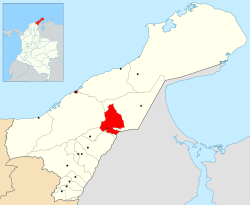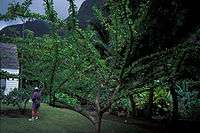Albania, La Guajira
| Albania | |||
|---|---|---|---|
| town | |||
| |||
|
Nickname(s): "Princesa Negra" (Black Princess) | |||
 Location of the town and municipality of Albania in the Department of La Guajira. | |||
| Country | Colombia | ||
| Region | Caribbean | ||
| Department | La Guajira | ||
| Foundation | January 27, 1801 | ||
| Government | |||
| • Mayor |
Yan Keller Hernandez[1] (Movimiento ALAS-Equipo Colombia) | ||
| Area | |||
| • Total | 425 km2 (164 sq mi) | ||
| Elevation | 320 m (1,050 ft) | ||
| Population (2005) | |||
| • Total | 20,898 | ||
| [2] | |||
| Website |
albania-laguajira.gov.co/ | ||
| * | |||
Albania (previously known as Calabacito from the Spanish meaning Small Calabash tree) is a town and municipality of the Colombian Department of La Guajira. Is the youngest municipality of this Department along with the town of Uribia and others, created on March 19, 2000. Albania neighbors and exclusive enclosed camp site for the Cerrejón coal mine workers and their families, named Mushaisa.[3]
Geography
The municipality of Albania is located in the Guajira Peninsula, northern Colombia presenting a predominantly flat and arid terrain by the steps of the Serranía del Perijá to the east and the Sierra Nevada de Santa Marta to the west, within the basin of the Ranchería River. The municipality of Albania limits to the north with the municipality of Maicao; to the east with the Bolivarian Republic of Venezuela and Maicao; to the south with the municipalities of Hatonuevo, to the west with the municipalities of Hatonuevo and Riohacha.[4]
The municipal seat is located at 72° 56’ east y 98° 08’ north. The municipality has a total area of 425 km². Since May, 2001 the Colombian government authorized an urban corridor between Albania and the locality of Cuestecitas of approximately 95 km² pertaining to the mining zone. The municipality has one of the largest deposits of coal in Colombia.[5]
History

The village of Calabacito was founded in the early 19th century and was first inhabited by indigenous groups pertaining to the Cocinas, Cariachiles and Wayuu who, due to their nomad traditions abandoned the area. It was repopulated later by former African slaves or their descendants probably escaping from the settlements of Moreno, Tabaco or Barrancas.[6]
These first inhabitants were blacks or mulattos and probably came also from a settlement known as "Soldado" in the early 20th century by 1903 escaping from political persecution or the civil war itself in which Colombia was engulfed between 1899 and 1902 known as the "Thousand Days' War".[6]
The first settlers apparently were seeking to establish agricultural production. The area was largely populated by Crescentia cujete (Calabash trees) colloquially known as Calabazos or Totumos.[6]
Politically and administratively, Albania was along the settlements of Manantial, Cuestecitas and Los Remedios under the mandate of the Province of Santa Marta (Sovereign State of Magdalena) until the year 1911 when it became part of the Special Commissary of La Guajira. The name of Calabacito was changed in 1937 by a commissar of La Guajira named Eduardo Londoño Villegas, who named it after his wife Alba or as other version suggests, after the country in the Balkans, Albania.[6]
During the military dictatorship of Gen. Gustavo Rojas Pinilla, Albania was annexed officially by Decree 1824 of 1954 to the Special Commissary of La Guajira; integrated by Uribia (then capital) and the village of Maicao. Along Albania the villages of Cuestecitas and Manantial were also included through Executive Decree 807.[6]
By Law 105 of December 12, 1960 the government of Colombia created the National Intendency of La Guajira, legalized by Decree 1824 by legislative act 1 of December 28 of the same year making La Guajira a department. The legislative act was officially enforced on July 1, 1965.[6]
Albania became a municipality on March 27, 2000 by Ordinance 001 passed by the Department Assembly of La Guajira, presented by then deputy Alvaro Gustavo Rosado. The first Mayor of Albania was Adel Enrique Pinto, designated by Decrere 080 of March 29, 2000.[6]
Politics
Administrative divisions
Corregimientos
- Cuestecitas
- Los Remedios
- Porciosa
- Wareware
Veredas
- Urapa
- Paradero
- Santa Fé
- Amarre
- Campo Herrera
- Piedra Amarilla
Indigenous reserves
- Resguardo Indígena Wayúu de la Alta y Media Guajira
- Resguardo Indígena Wayúu Cuatro de Noviembre
Demographics
In 2001 the population of Albania was of approximately 8,637 inhabitants with 3,535 of these living in the seat of the municipality. There were 707 homes and some 807 families.[7] The area is a traditional territory of Wayuu indigenous tribe influence.
In the 2005 census, 67% of people in the municipality of Albania lived in houses, 19% in apartments and 13% in a studio or rented room. 6.1% of these had a home based economy. 72% of the population had electricity service, 43% had sewer services, 66% had aqueduct service, 27% had natural gas service and 24% had a home telephone.[8]
the population of Albania in terms of gender is made up by 51% of males and 49% of females, presenting a relatively young population. 29% of these considered itself indigenous while a 10% mestizo, raizal or Afro-Colombian.[8]
References
- ↑ "Colombian Registry of the Civil State: 2007 election results" (in Spanish).
- ↑ "Observatorio del Caribe Colombiano: Grupo Regional de investigación en economía y competitividad en el Caribe colombiano by Weildler Guerra, Paola Quintero, Jorge Quintero and Ana María Maldonado" (PDF) (in Spanish).
- ↑ "Gobernacion de La Guajira - Albania: generalities".
- ↑ "Albania: Geography. Border limits" (PDF).
- ↑ "roboroz.ca: Albania - geography".
- 1 2 3 4 5 6 7 Nayder Yesit Magdaniel Ojeda (2002). "Ciudad de Moreno: Origen y Destrucción". Albania official website (in Spanish). Retrieved 2008-03-26.
- ↑ "roboroz.ca: Albania - population".
- 1 2 "Census 2005: Albania" (PDF).
External links
- (Spanish)albania-laguajira.gov.co/ Albania official website
- (Spanish)Gobernacion de La Guajira - Albania
- (Spanish)Albania townhall
- (Spanish)Albania
- (Spanish) Albania: Generalities expanded
| ||||||||
Coordinates: 11°09′35″N 72°35′08″W / 11.1597°N 72.5856°W
.svg.png)
